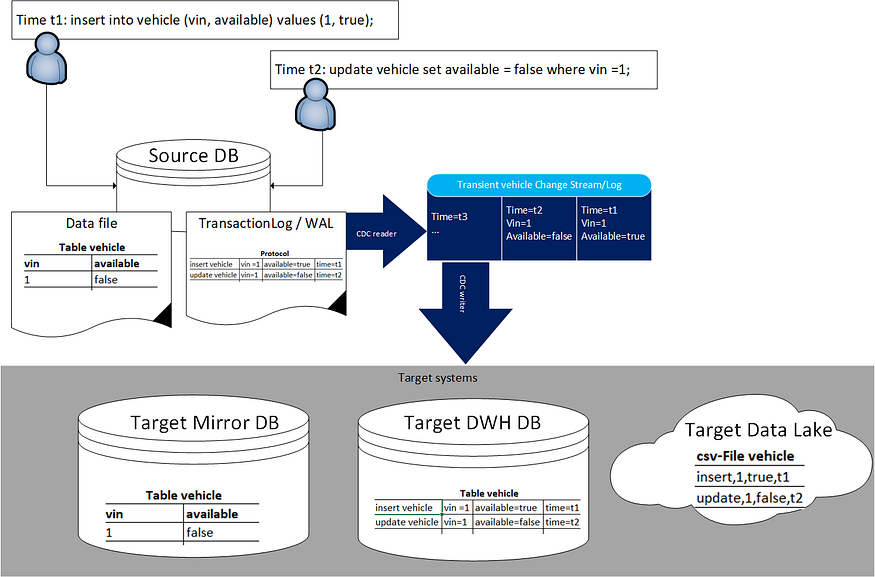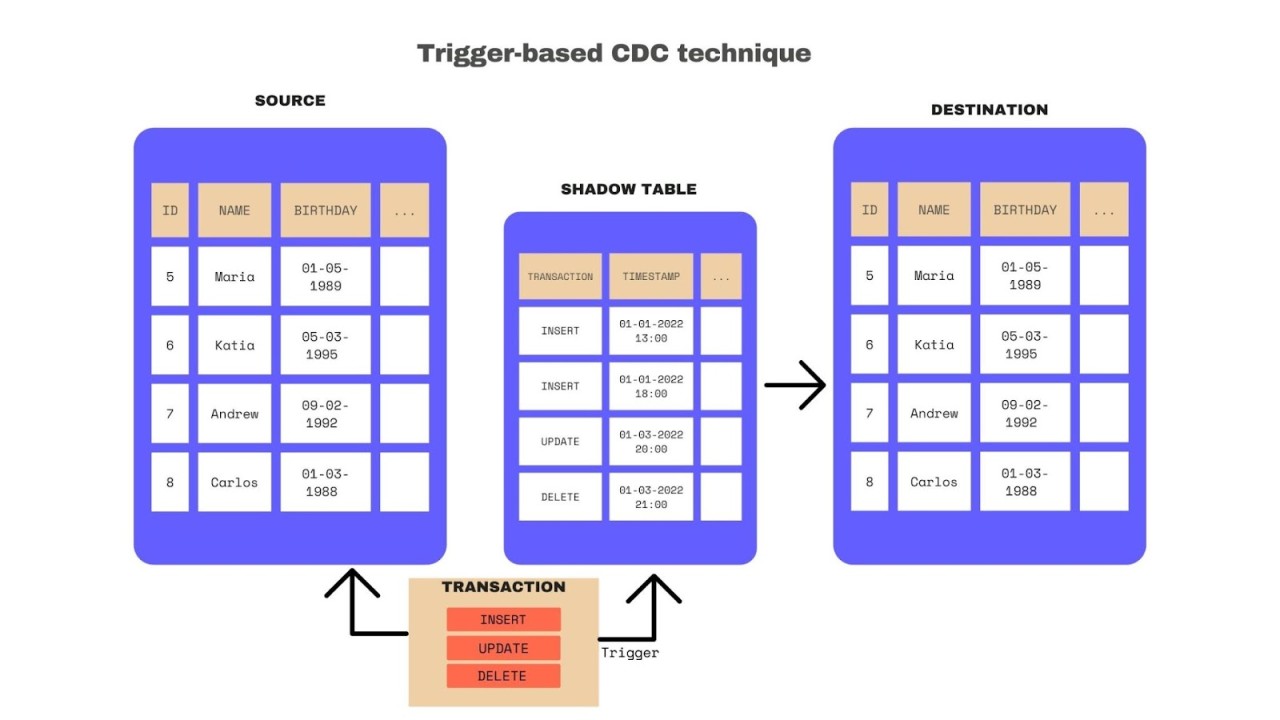What if your databases could sync instantly, providing real-time data for analytics and decision-making? Change Data Capture (CDC) makes this possible by tracking database modifications, ensuring smooth data flow between systems. This article guides you through CDC’s role in contemporary data management, strategies for effective implementation, and explores its impact on data warehousing and real-time analytics without over-complicating the explanations.
Key Takeaways
- Change Data Capture (CDC) offers a method for real-time or near-real-time data integration, capturing and transmitting data changes incrementally, therefore reducing bandwidth and costs compared to full data loads.
- CDC is strategically significant for enabling real-time analytics, data warehousing, and consistent cross-platform data updates, thus playing a critical role in informed decision-making in fast-paced environments.
- Implementing CDC can revolutionize data warehousing and ETL processes by allowing incremental updates, reducing the need for extensive data processing time and resource usage, and optimizing data flow efficiency.
Exploring the Essentials of Change Data Capture (CDC)
Change Data Capture (CDC) operates much like a watchful sentinel, constantly monitoring for changes within a database-be it inserts, updates, or deletes. It operates with surgical precision, capturing these changes directly from the database transaction log and funneling them to their destination. This method of incremental data loading is not only frugal in bandwidth but also a time-saver, thus slashing costs that would otherwise balloon with full data loads. By efficiently handling changed data, CDC ensures a seamless data capture process.
CDC shines when it transmits data changes in manageable increments from the source database to the target system, either in real-time or near-real-time, eliminating the need for burdensome bulk loads or batch processing windows. The CDC toolkit is replete with methods such as trigger-based and log-based techniques, the latter renowned for its minimal impact on database performance.
The Strategic Importance of CDC in Today’s Data-Driven World
In a world where data velocity takes the crown, CDC emerges as a crucial component in keeping data consistency across platforms updated to the minute. It fuels real-time analytics, fortifies data warehousing, and ensures that applications are always equipped with the latest data. The strategic advantages of CDC are manifold, including the assurance of data consistency, which is paramount for informed decision-making in high-velocity environments.
CDC’s prowess is not limited to consistency; it extends to a suite of benefits such as:
- Real-time updates
- Offload reporting
- Business continuity
- Reduced workload
- Automated data synchronization
These contribute to a robust data management system that underpins astute decision-making. Incorporating CDC into your data management strategy opens up the possibility for continuous data extraction, offering a constant flow of updated information from multiple data systems. This reliable data source drives your operations and enhances your data warehouse.
How CDC Enhances Data Warehousing and ETL Processes
The incorporation of CDC into data warehousing and ETL processes is truly revolutionary. By enabling incremental updates, CDC mitigates the need for exhaustive processing time and resource consumption, which are hallmarks of full data loads. At the transformation stage, CDC elevates efficiency by promptly loading data as it undergoes changes at the source, followed by the application of transformations at the target repository.
CDC’s role in data ingestion is pivotal, serving as the extraction phase within ETL and capturing data changes to load them efficiently into modern data repositories such as cloud-based data warehouses and data lakes. Automated CDC tools within ETL processes are adept at managing voluminous data, thereby sharpening the precision and optimizing the efficiency of the entire data workflow.
Diving Into CDC Techniques: A Closer Look at Methods
Change Data Capture methods come in a wide variety and are highly sophisticated, with each technique like log-based, trigger-based, and timestamp-based offering their unique benefits and potential downsides. These methods are vital cogs in the machine of data capture, and understanding their nuances is key to harnessing the full power of CDC.
We will examine each technique and evaluate its strengths and weaknesses.
Log-Based CDC: Minimizing Impact on Database Performance

Image Credit Source
Log-based CDC operates discreetly behind the scenes, parsing new transactions from database transaction logs with minimal disruption. This method is often the go-to for organizations aiming to keep their database performance humming along unfettered. It thrives on the asynchronous reading of transaction logs, enabling real-time data capture while sparing the database any computational strain.
Transactional consistency is a given with log-based CDC, thanks to the inherent properties of transaction logs that maintain transaction boundaries and commit order. While traditional batch processing can be a CPU hog, log-based CDC practices restraint, ensuring that the database’s CPU remains unburdened.
Trigger-Based CDC: Immediate Data Capture
Image Credit Source
Trigger-based CDC is the epitome of immediacy, capturing data changes as they occur through the firing of database triggers into a parallel change table. This automatic execution of stored procedures on database events like INSERT, UPDATE, or DELETE ensures that data is captured without delay. Despite its promptness, trigger-based CDC requires the maintenance of a separate table for change capture and may exert a computational toll on database performance due to trigger overhead.
Timestamp-Based CDC: Tracking Changes Over Time
Timestamp-based CDC is the embodiment of simplicity, using row timestamps to track changes and capture data since the last extraction event. However, this method comes with its own set of handcuffs-it cannot identify deleted rows, presenting a notable gap in capturing a complete data picture.
Real-World Applications: CDC Use Cases Across Industries
The applications of CDC span as wide as the industries that utilize them. CDC’s capabilities are instrumental across various sectors like:
- Finance
- Healthcare
- Retail
- E-commerce
Whether it’s warehousing, replication for high availability, or data migration, the use cases for CDC demonstrate its expansive utility.
Achieving Continuous Data Replication
Continuous data replication is a cornerstone of CDC, ensuring that data remains consistent and available across source and target systems. Banks, for instance, can leverage CDC to maintain an accurate and current view of their data, with various synchronization methods like one-way replication or bi-directional synchronization tailored to their unique needs.
CDC also plays a pivotal role in cloud migrations, facilitating incremental data replication and optimizing network bandwidth usage.
Empowering Real-Time Analytics and Reporting
CDC is a catalyst for:
- Real-time data movement, which is critical in powering analytics
- Enabling zero-downtime database migrations
- Immediate insights available for dynamic reporting
- Faster and more accurate decision-making as real-time data updates are readily accessible.
In the retail sector, real-time analytics powered by CDC can lead to dynamic adjustments of product displays and pricing in response to live customer activity.
Streamlining Cloud Migrations and Hybrid Architectures
CDC is a cornerstone in facilitating the migration of data to cloud platforms, guaranteeing dependable data synchronization between on-premises and cloud environments. Organizations lean on cloud environments to drive down total cost of ownership, boost agility, and foster new digital experiences, making the role of CDC in these transitions more crucial than ever.
Selecting the Right CDC Solution for Your Business
In selecting a CDC solution, several factors should be considered, including compatibility, scalability, cost-effectiveness, ease of setup, and long-term maintenance. Log-based CDC methods stand out for their compatibility with different database management systems and their ability to mesh with various ETL tools and source/target systems. It’s important to choose a CDC tool that can handle the complexities of your data architecture and is compatible with your specific data types, database structures, and unique use cases.
Additionally, the chosen solution should offer user-friendly configuration, swift problem resolution, and be accessible to both technical and non-technical teams. The total cost of ownership is also a vital consideration, encompassing factors such as initial investment, hosting fees, onboarding costs, and long-term maintenance.
Implementing CDC Best Practices
Best practices in CDC implementation extend beyond the mechanics of data capture and encompass the accuracy, reliability, and performance of the data capture process. These are essential for maintaining a high-quality data pipeline. CDC technology not only captures data changes but also the associated metadata, which is crucial for auditing and compliance, especially under regulations like AML and KYC.
Providing a detailed audit trail of data modifications, CDC enables the capture of each change as a definable event, which can be critical for compliance reporting processes.
Advancing Your Data Strategy With CDC
Incorporating CDC into your data strategy, including the use of a data lake, signifies readiness to adapt to changing data environments and schema alterations. Log-based CDC, in particular, is adept at adjusting to database schema changes, ensuring seamless data integration and real-time insights.
By leveraging CDC’s capabilities, organizations can ensure that their data strategy remains robust, flexible, and aligned with the shifting landscapes of data and technology.
Summary
Throughout this exploration, we’ve seen how CDC acts as a key player in the modern data ecosystem, enabling real-time data integration and enhancing data warehousing and ETL processes. By understanding and implementing the various CDC techniques-log-based, trigger-based, and timestamp-based-businesses can choose the right CDC solution to fit their specific needs. Whether it’s streamlining cloud migrations, empowering analytics, or ensuring continuous data replication, CDC is an invaluable asset for any data-driven organization.
As we conclude, let the transformative potential of CDC inspire you to reimagine your data strategy. With the right approach and CDC tools, CDC can be the catalyst for a more efficient, insightful, and proactive business model. The future of data is real-time, and with CDC, that future is within your grasp.
The post Change Data Capture: A Practical Guide to Real-Time Data Integration appeared first on Datafloq.


